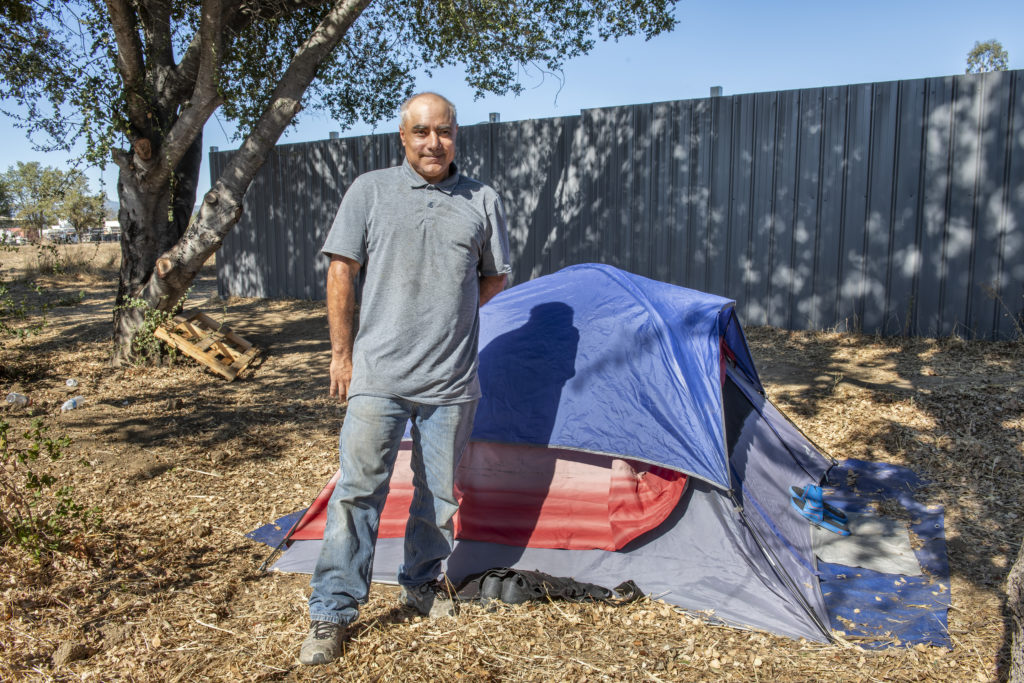Editorial: Homelessness can be solved when society demands it
Here in Santa Clara County, one of the wealthiest places in the world, about 600 families are now experiencing this condition
![]()

Photo courtesy Kirsti Fatania-Bassendine
Tony, a homeless man, lives in a tent near a creek in Gilroy.
Editorial is the opinion of Gilroy Life
The man spent his last days in downtown Morgan Hill. He slowly and silently pushed through the streets a shopping cart stuffed with his worldly possessions. Often, he could be seen sitting on benches, his sad eyes staring vacantly at the ground. Occasionally, good-hearted people gave him food and water. On the cold and rainy morning of Dec. 28, his body was found face down under the side entrance to a bagel shop.
 Due to privacy reasons, we are unable to share the man’s name. But let us consider in his last days he felt emotional pain dealing with the challenges of not having shelter and depending on the help of strangers.
Due to privacy reasons, we are unable to share the man’s name. But let us consider in his last days he felt emotional pain dealing with the challenges of not having shelter and depending on the help of strangers.
Many of us are depressingly familiar with the tent settlements along our highways and creeks. It’s estimated there are more than 10,000 individuals in the county without adequate shelter. That’s a tragedy.
The political implications of mass homelessness shake the foundations of democracy. We saw last year how mass homelessness in the state served as a major theme to recall Gov. Gavin Newsom. News opinionators have commented that widespread homelessness is proof the “American dream” is dying and serves as a symptom of our democratic and economic decline.
 Especially disheartening is the fact too many families are forced by circumstances to live in tents, RVs and cars. Here in Santa Clara County, one of the wealthiest places in the world, about 600 families are now experiencing this condition. Another 600 families will enter homelessness for the first time every year. Seventy-five percent of these families have a female head of household and 62 percent self-reported having children enrolled in school.
Especially disheartening is the fact too many families are forced by circumstances to live in tents, RVs and cars. Here in Santa Clara County, one of the wealthiest places in the world, about 600 families are now experiencing this condition. Another 600 families will enter homelessness for the first time every year. Seventy-five percent of these families have a female head of household and 62 percent self-reported having children enrolled in school.
In October, a coalition headed by the county’s Housing Authority launched a campaign with a goal to house all of the county’s homeless families by 2025. Called “Heading Home: No More Families Living on Our Streets,” the project aims to achieve “functional zero” in five years, meaning the number of housing placements for families is greater than the number of families entering homelessness.
To achieve this ambitious goal, the campaign will focus on four key strategies:
-
Leveraging Emergency Housing Vouchers: The Santa Clara County Housing Authority has been awarded about 1,000 emergency housing vouchers providing rental support to homeless households for up to ten years. The vast majority of these vouchers will be targeted towards homeless families.
-
Expanding Rapid Rehousing: The coalition will expand its Rapid Rehousing programs, which provide a time-limited rental subsidy along with case management and supportive services. The goal is to serve another 200 homeless families annually.
-
Expanding Homelessness Prevention Strategies: The coalition will work to expand homelessness prevention services so that fewer families fall into homelessness. This includes plans to expand the Homelessness Prevention System to serve 2,500 households by 2025 as well as new investments in Housing Problem-Solving programs, which quickly house families who recently became homeless and are sleeping on the street or in a place not fit for human habitation.
-
Creating More New Affordable and Supportive Housing: New affordable housing developments in the Measure A pipeline include about 1,000 new family apartments in five years. There is also the potential to expand further by leveraging $1 billion in Project Homekey funding dedicated to families.
We encourage our leaders to also help individuals — including teenagers, veterans, and the elderly — forced to live on the streets. Homelessness is a problem that can be solved when society pushes the politics. It’s also a moral imperative for us to take care of those who face life challenges as a homeless individual — including the man who died alone in downtown Morgan Hill three days after Christmas.
